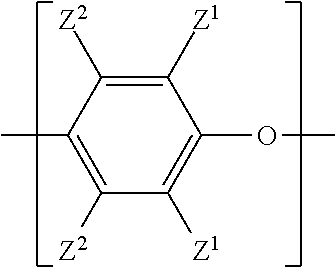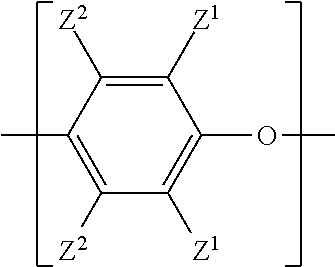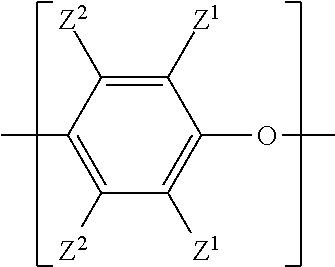Methods utilizing polyamide-poly(phenylene ether) compositions
a technology of polyamide and phenylene ether, which is applied in the field of methods utilizing polyamidepoly (phenylene ether) compositions, can solve the problems that the polyamide-poly(phenylene ether) blends have not achieved widespread application in other aspects of the oil and gas industry
- Summary
- Abstract
- Description
- Claims
- Application Information
AI Technical Summary
Benefits of technology
Problems solved by technology
Method used
Image
Examples
examples 1-5
[0092]These examples illustrate variations in the polyamide-poly(phenylene ether) composition. Components used to form the compositions are summarized in Table 1.
TABLE 1ComponentDescriptionPPE 0.40Poly(2,6-dimethyl-1,4-phenylene ether), CAS Reg. No. 25134-01-4,having an intrinsic viscosity of about 0.40 deciliter per gram as measured inchloroform at 25° C.; available as PPO ™ 640 from SABIC InnovativePlastics.PPE 0.45Poly(2,6-dimethyl-1,4-phenylene ether), CAS Reg. No. 25134-01-4,having an intrinsic viscosity of about 0.45 deciliter per gram as measured inchloroform at 25° C.; available as PPO ™ 800 from SABIC InnovativePlastics.PAPolyamide-6,6, CAS Reg. No. 32131-17-2, having a viscosity of about 126milliliters / gram measured in 90% formic acid according to ISO 307;available as STABAMID ™ 24 FE 1 from Rhodia.SBSButadiene-styrene block copolymer, CAS Reg. No. 9003-55-8, having apolystyrene content of about 30% and a melt flow index of about 5grams / 10 minutes, measured according to AS...
PUM
| Property | Measurement | Unit |
|---|---|---|
| weight percent | aaaaa | aaaaa |
| weight percent | aaaaa | aaaaa |
| weight percent | aaaaa | aaaaa |
Abstract
Description
Claims
Application Information
 Login to View More
Login to View More - R&D
- Intellectual Property
- Life Sciences
- Materials
- Tech Scout
- Unparalleled Data Quality
- Higher Quality Content
- 60% Fewer Hallucinations
Browse by: Latest US Patents, China's latest patents, Technical Efficacy Thesaurus, Application Domain, Technology Topic, Popular Technical Reports.
© 2025 PatSnap. All rights reserved.Legal|Privacy policy|Modern Slavery Act Transparency Statement|Sitemap|About US| Contact US: help@patsnap.com



